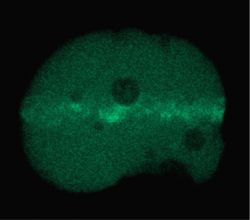Sussex study unravels mystery of a DNA repair process
Sussex scientists have uncovered the mechanism of a key process in DNA repair that helps to prevent neurodegenerative diseases such as ataxia.
 Cell damaged by UVA light, as shown by the stripe, undergoing repair by enzymes
Cell damaged by UVA light, as shown by the stripe, undergoing repair by enzymes
A four-year study led by Dr Sherif El-Khamisy at the Genome Damage and Stability Centre has focused on the behaviour of enzymes within cells that are involved in the repair of faults in DNA - the genetic material in our cells and all other living organisms.
The most common fault to occur spontaneously in DNA is single strand breaks (DNA being composed of two twisted strands). Failure to correct these breaks has been shown to lead to neurodegenerative disorders (those that attack the nervous system).
Previous research has shown that a particular enzyme, TPD1, is critical for repairing one type of these breaks, but it was not known how this enzyme reached sites of DNA damage.
Now Dr El-Khamisy and his team have identified a peptide (a small protein composed of approximately 100 amino acids) within cells, named SUMO, which helps bring TPD1 to the lesion to repair it.
This process is particularly important in cells that experience a high level of lesions and are unable to self-replicate, such as brain cells (neurons).
Dr El-Khamisy said: “These findings were a surprise since it was known that this enzyme was important but it was an unresolved mystery as to how it reached the site of damage to deal with this kind of break.
“We were not expecting to find that this enzyme was modified by SUMO peptides, nor were we expecting to find that this modification helps to recruit this enzyme to the site of damage.”
He said the results of this study, funded by the Wellcome Trust and published on Tuesday (13 March) in the journal Nature Communications, will enhance the assessment of disorders such as the hereditary neurological disease, ataxia.
“Addressing how these fascinating enzymes work will not only determine the importance of repairing DNA damage for preventing neurodegenerative disease but might also identify novel markers for improving human health and promoting a healthy elderly population.”
The next step for Dr El-Khamisy and his team is to look at environmental factors and drugs that affect this process, such as anti-cancer agents, ultra violet light and radiation.
